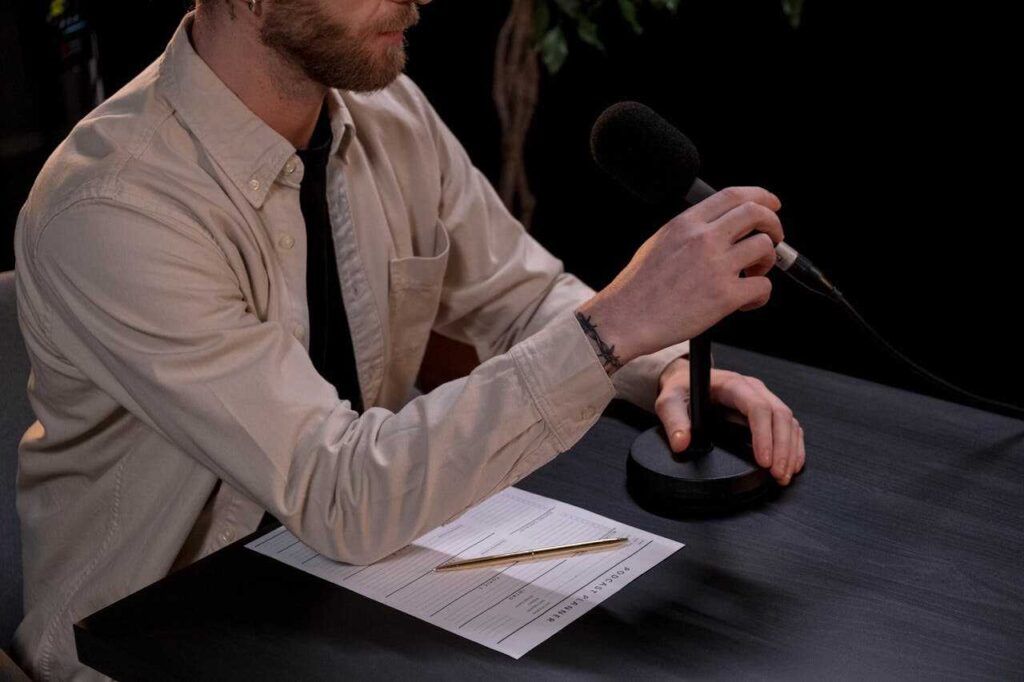I interpret German, Romanian, and English – simultaneously, consecutively, or in whispering mode. Whether it’s an international conference, a works council meeting, or a technical discussion, I make sure every word hits the right note.
I work on-site or online via Remote Simultaneous Interpreting (RSI), carefully prepare terminology and topics, and coordinate with technical or event teams when needed.
The goal: seamless communication – clear, precise, professional.


I interpret simultaneously at conferences, meetings, and presentations – with focus, precision, and a fine sense for tone and pace. In this mode, I relay what is said almost in real time to keep communication flowing smoothly.
In consecutive interpreting, I speak after the speaker pauses – for example in business meetings, interviews, or short speeches. This format is ideal when direct contact matters more than speed.

A successful conference starts with thorough preparation. I support you in choosing the right interpreting mode, the necessary technical equipment, and the optimal room setup.
From planning to execution, I assist you with hands-on experience from international events. I coordinate interpreting teams, advise on technical requirements, and ensure that your event runs smoothly.

I regularly work on RSI platforms such as Zoom, Interprefy, Webex, and Kudo – with reliable technology, professional equipment, and stable connections. This enables meetings and conferences to run smoothly even across long distances.
Whether hybrid events, online training, or international conferences – I ensure that communication also works seamlessly in the digital space: clear, secure, and in real time.
The cost depends on the type, duration, and subject of the assignment. Interpreting is usually charged at daily rates; preparation time, travel time, and technical setup may be added. You will always receive a transparent, tailored quote.
In simultaneous interpreting, speech is transmitted into the target language almost in real time. This mode requires maximum concentration and usually takes place in a soundproof booth using headphones and a microphone. It is ideal for conferences, conventions, and hybrid events.
In consecutive interpreting, the speaker talks in segments while the interpreter takes notes and then renders the message accurately in the target language. This method is suitable for smaller meetings, interviews, receptions, or speeches.
In whisper interpreting, the interpreter sits or stands right next to one or two listeners and quietly interprets simultaneously for them. It’s a discreet solution for individuals, but only practical for short assignments in a quiet environment.
That depends on the type and duration of the assignment. For simultaneous interpreting, interpreters always work in pairs because the level of concentration required is extremely high. They take turns roughly every 20–30 minutes.
For shorter assignments, one interpreter is usually sufficient. However, if the assignment lasts longer than about an hour or involves multiple languages, a team is the professional and necessary solution.
Every event has its own terminology, dynamics, and target audience. Interpreters must prepare not only linguistically but also in terms of content — understanding technical terms, names, products, and internal processes. Presentations, speeches, agendas, or background texts help them grasp the speaker’s style, line of reasoning, and any abbreviations.
This allows technical terms to be rendered accurately and misunderstandings to be avoided. A well-prepared interpreter works more precisely and fluently, contributing significantly to a professional and credible event.
Often yes, since travel and technical setup are not required — especially for short assignments. However, the choice depends on the format, platform, and type of event. For large multilingual meetings, on-site interpreting is often more stable and engaging.
An agency can make sense — but usually only for very large projects involving multiple languages or teams. In all other cases, you benefit from direct contact and clear communication.
In addition, agencies typically charge a markup, which means higher overall costs for everyone involved.